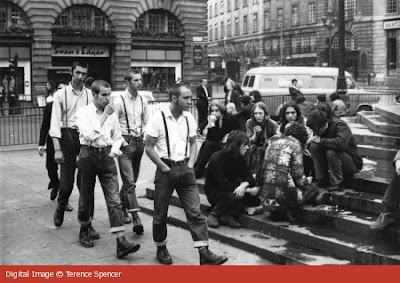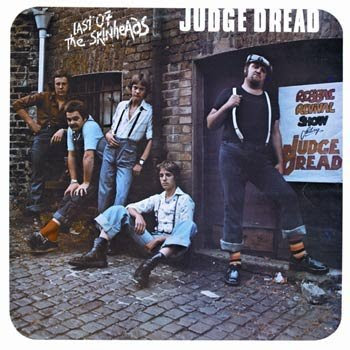Cal, 54, is a squat, square, bald-headed pit bull of a man. Standing about 5' 7" in his AirWare soles, his M1 flying jacket looks as if it has just been washed, his too-tight stone-washed jeans have a central crease, the dark blue Fred Perry is almost new. Diamonds of light sparkle on his ox-blood DMs, occasionally the fat sovereign ring on his left hand dully threatens to rip the side pocket on his jacket.
"You mightn't reckon it now, but once a time I was a scary suede head," his smile leans forward like a shark having a sniff at an unexpected foodstuff.
"Back in the early '70s I was a Shed Ender, spent Saturdays either ripping into train seats or dickheads who weren't Chelsea. That was when I could afford to get to London, 'course. If I couldn't bunk a train I'd get my hair trimmed of adorning, have a couple of pints and then see me bird 'til it was time to go out and start a ruck in a pub or disco."
These days Cal spends Saturdays minding the counter at the newsagents he runs, nipping across to the bookies with a bet or two and waiting for closing time so he can have a couple of pints before heading home to get ready.
"There's usually a '70s disco or Northern Soul night on somewhere round here, so me and missus number 3 like to get done up, have a few and shake it about on the dance floor. It's funny though," Cal doesn't look amused, "I never used to dance much back then. I was always too pissed or busy trying to start a fight in the bogs".
Back in 1972 Cal was a trainee Headhunter, one of a handful of 4th formers who'd earn their place in the hooligan hierarchy by leading what looked like suicidal attacks on rival football teams supporters. "We'd have to get stuck in on our own for a good 5-10 minutes while the big boys watched from round a corner or something," Cal's fat neck creases with the effort of shaking his head, "and if we stood our ground—against proper hooligans sometimes, like the Inter City Firm—then we'd get bought beer all night by the bosses. Sometimes though we had to run, and get the dopes to follow us into a trap, the Headhunters would jump them as they came round a corner, swinging chains, slicing with Stanley knives and all that." The top of Cal's left ear and right cheek just below his eye still carry scars where he didn't get away in time. Not that he ever ran away unless told to by a Headhunter.
Cal's fledgling hooligan career was begun as a skinhead in 1970, but two years later he wore the longer crop and sideburns of a suede head. "I also had an 'orrible little moustache like Hitler when I was 15," his grimace is a frightening sight. "But that was mainly to show my old man that I was as big and tough as he was". Cal's old man was a builder's foreman, bald since the age of 21 he was a former Teddy Boy who used his fists to instil discipline in his kids and building site crew alike. "He was a tough bastard," Cal recalls (not at all fondly).
"I did a couple of summers working with him on a site in the West Country, building a prison, I think it was. We slept in a caravan and drank scrumpy after work every night, ate fish and chip suppers, smoked roll ups. He spent his life working away from home all week, coming back to our house at the weekend. I hardly knew him." Cal didn't know his old man well enough to not call him out one Saturday night in mid-winter.
There was a power cut on and his old man had rigged up a gas-powered arc lamp he 'borrowed' from work in the yard outside the kitchen window. "It was bloody bright, made every shadow in the place huge." Dinner was, as usual, a silent affair. "My old man ruled the place and told us when to talk. I was fifteen and had been running with the Headhunters for a while so I thought, 'I'm not having this', and I started talking some bollocks to my little brother. The old man said 'shut it'. I said, 'No, you shut it'. Well, he turned red. 'Think you're hard enough son?' he asked. 'Outside then'. The old lady started crying and I almost shat myself but thought, 'gotta do it, he's an old man…'."
The fight was short. "He hit me once and that arc light went out. I never stood a chance." It was the beginning of the end of Cal's hooligan phase. "I thought, if I can't beat him, I'm going to lose it to some tosser sooner or later, maybe I'll give something else a look." Plus, it saved him some money. "Yeah, well, I went to live with my old gran the week after that. I couldn't face him even at weekends. Plus, I had a bird I was serious about at the time—Angie, just like in that song—and she was allowed stay over at Grans. So we'd spend Saturdays shopping, dancing, seeing some gigs and that. I remember going to see Ronnie Lane's Slim Chance in a field the summer after, and he was growing out the suede head look, which I kinda started doing. Mind you, I didn't go in for that hippy look. Had to stay smart, eh?"
Cal's old man died at 46 of a heart attack. "Dropped dead at work apparently, in the middle of bollocking someone. Stupid bastard." Cal's laugh sounded like a dog hiccupping. "I didn't hate him, though. He did what he thought he had to do, and he probably saved me from a few extra scars." He shrugs, or twitches his shoulders at least.
"Now, any time I want to remember him and what he was, I just go and look in the mirror. A few years back I thought I saw him in shop window, gave me a right shock. 'It's him, my old man!' I thought, and turned round to say something. 'Course he wasn't there. It was my own bloody reflection. What a twat, eh?" That hiccupping dog returns for a long minute. Then Cal slowly shakes his head, wipes what might be a tear from the scar under his eye and waddles off to look for missus number 3. There's a Faces tribute band playing tonight in a pub up the road. Of course they're going.






































